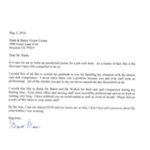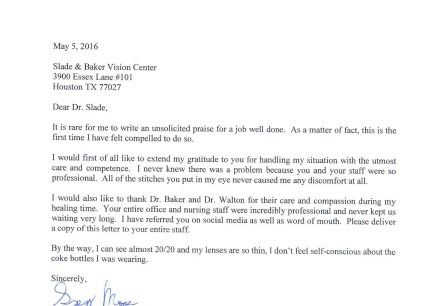
At this time, research statistics of Ehlers-Danlos Syndrome (EDS) show the prevalence of EDS as 1 in 2,500 to 1 in 5,000 people. The collagen in someone with Ehlers-Danlos Syndrome is not structured the way it should be, and in some cases, only part of it is produced. With badly built or processed collagen, the tissue that relies on it can be pulled beyond normal limits and become damaged.
Collagen is the most abundant protein in the body and can be found almost anywhere: in skin, muscles, tendons and ligaments, blood vessels, organs, gums, eyes, etc. Therefore, this syndrome unfortunately affects all of these parts of the body, including a patients corneas, which tend to be thinner than the corneas of someone without EDS.
Due to this, a patient suffering from EDS that is undergoing a standard procedure like cataract surgery, can be subjected to some scary potential risks or outcomes that a “normal” patient usually wouldn’t have to worry about.
Gregg M. came to us after googling “best cataract surgeon Houston”. He told us he knew his condition was tough and he wanted to be sure the person operating on his eyes was the best of the best. He found our website on the internet, watched some of the youtube videos of procedures performed by Dr. Slade, and then he shared: “I prayed about it.” He determined that our office would be where he would take his risk.
After recovery, Gregg shared that he had 11 stitches in his left eye and 4 in his right eye during his cataract surgery. These days, cataract surgery is “stitchless”, “seamless” and many times completed with a femtosecond laser. Due to Gregg’s rare condition, Dr. Slade’s usual standard surgery procedure changed…and it changed while his patient was on the surgical table.
Gregg wrote our office a beautiful letter which we have attached below. He raved to us about our staff, how comfortable they made him, their care, compassion and professionalism. He even shared that he knew it was meant to be and he was in amazing hands when Dr. Baker gave him his personal cell phone number in case anything went wrong.
But what struck us is what we take for granted so much. The immense skill it takes for a surgeon to have to fight a dangerous, risky turn while during surgery. “Dr. Slade handled my case and did not make me nervous or uncomfortable.” Gregg shared he has the utmost respect “for how Dr. Slade could anticipate any problems” that may surface even during surgery.
As he states in his letter:
“I never knew there was a problem because you and your staff were so professional.”

Per Dr. Slade, Mr. Gregg M.’s corneas were so thin and made of such fragile tissue, his wounds had to be sutured to seal them. This explains the need for multiple stitches. We asked Dr. Slade to tell us in regular people words what this meant. He told us to think of what it would be like to have to sew wet tissue paper.
At the end of the day, regardless of the scare, the risk and the nerves, Dr. Slade got a happy patient, with an amazing outcome who wanted to share his experience with the world. Mr. Gregg M. wants all patients affected with EDS to know they have someone they can trust with eye surgery.
He shared he has some very thin lenses he uses now that are very unlike his “coke bottle” glasses from before and he claims he can see way better now even without his glasses! We are so happy that his procedure went the way it did and that he is doing his part in spreading awareness about EDS and eye procedures.
We thank you Gregg for your feedback and we hope to help more patients as sweet as you.
If you or someone you know has been diagnosed with Ehlers-Danlos Syndrome or any other rare condition that affects the corneas, please call us today at
. Our doctors can help evaluate you and do their best to treat your vision!





